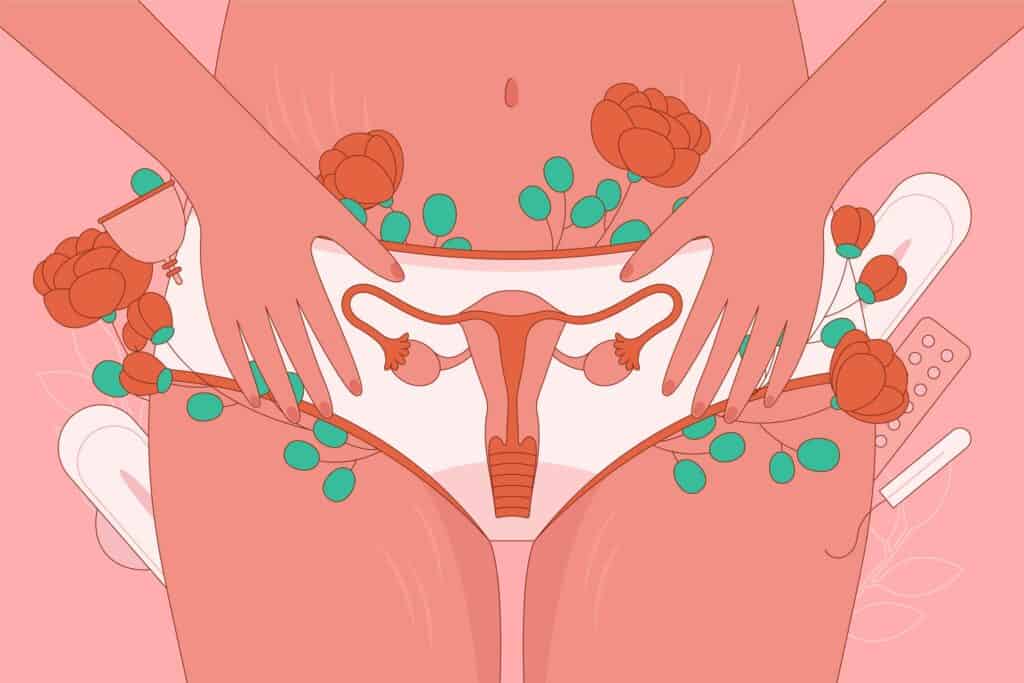4 Types of (Clear) Watery Discharge: 5 Methods to Ease Vaginal Discharge Discomfort
The vagina is the entry to your reproductive system. Your body produces pH to create an acidic environment that prevents bacteria content from passing through the cervix. This process ensures that your reproductive system is protected from infection.
In this article, you will see why vaginal discharge is normal and how the discharge cleanses the vagina of bacteria.
Clear vaginal discharge is normal in most cases and even associated with good health. The clarity of the discharge indicates that the body is doing its job. Your vagina’s pH levels are balanced, and the yeast and healthy bacteria are in good balance when the discharge is watery.
But your discharge will change during your cycle, too. Women can have creamy discharge, little discharge, and discharge that is egg-like (in ovulation). The good news is that all these discharge levels are normal, and they’re not a cause for concern.
4 Types (Colors) of Vaginal Discharge

Watery discharge is standard. Since every woman will produce different volumes of discharge, there is no normal type. If the discharge is simply watery, you can sleep well at night knowing that there’s no cause for concern.
But if other symptoms occur or you have different color discharge, you should be concerned.
If you have the following discharge, you’ll want to seek the help of a doctor:
- Yellow (pale or dark): The presence of yellow watery discharge is an indicator of gonorrhea or bacterial vaginosis. This discharge often smells fishy, and it is accompanied by itching of the vagina and pain when urinating or having intercourse.
- Cheesy: A woman that has cheesy watery discharge will notice a foul odor, too. This discharge is often a cloudy white that resembles cottage cheese. Yeast infections or bacterial vaginosis are two conditions that may cause cheesy discharge.
- Green: Green watery discharge is an indicator of chlamydia or trichomoniasis. This discharge will have a fishy, sour smell and is often accompanied by redness and pelvic pain.
- Gray: If you’re suffering from a gray watery discharge, this may be a sign of bacterial vaginosis. This condition will cause the discharge to have a strong odor, and it will cause itching and swelling of the vagina.
If the watery discharge has an odor or it’s more white than it is clear, this may be a sign of an infection. When we say “watery,” we mean water-like discharge clear in color and not white or a faint gray color.
4 Causes of Clear Vaginal Discharge

Wet vaginal discharge is normal. Your menstrual cycle will cause various discharge changes, and watery discharge is simply one of those changes. If you’re suffering from other symptoms, a trip to the doctor is recommended.
Women will find that there are four main causes or occasions when they experience this clear discharge.
Ovulation
If you want to get pregnant, ovulation provides the ideal environment for that. During this period, your chances of conceiving are the highest. The cervical mucus provides a stretchy, watery environment that allows sperm to swim through the cervix while being protected.
Remember, the mucus normally protects against infection, but it also helps enhance your chances of pregnancy.
Estrogen levels ramp up during ovulation, and this leads to vaginal discharge. This happens over a period of days, and the body produces 30 times the mucus it usually does during ovulation.
The increase in discharge results in a woman:
- Experiencing wet panty liner
- Noticing discharge trickles
There is an apparent “wetness” that occurs during ovulation. The discharge during ovulation is:
- Clear
- Watery
- Odorless
And the wetness will follow it by a period of dryness, and then your period.
Vagina Discharge During Pregnancy
Are you trying to conceive? If so, you may be pregnant. Some women will notice this watery discharge before taking a pregnancy test and confirming their belief that they’re pregnant. This discharge happens because of hormonal changes as you prepare for pregnancy. Your hormones will be all over the place.
Estrogen levels rise almost immediately after fertilization. These hormones prepare the body for pregnancy, which will eventually cause a significant uptick in cervical mucus. The mucus will become so heavy that it will cause what’s called a “mucus plug.” This plug keeps bacteria from entering the vagina to help protect the fetus until near labor.
Your vaginal discharge may even have streaks of blood.
If you have a watery, blood-streaked discharge, this can be a sign of implantation bleeding. Some women will notice spotting, while others have a slight watery discharge with small amounts of blood.
Vaginal discharge will persist during pregnancy, and this is normal unless it’s heavy and red.
If you have bleeding or continual deep red discharge, you’ll want to consult with a doctor to ensure that your baby is developing healthily.
After Intercourse
If you’ve just had sex or notice watery discharge during sex, this is caused by sexual arousal.
A woman that’s sexually aroused, as she will be during intercourse, will find that the discharge isn’t from the vagina. There are two glands above the vagina that cause the discharge to occur.
Your body produces this discharge to lubricate the vagina to help make penetration easier. Sometimes, women will notice that they have watery discharge for hours after sex. This is a sign that the glands haven’t stopped producing the discharge.
This is a normal occurrence and will stop on its own.
Watery Discharge Content During Period
Water can’t exit the vagina unless it’s forced into the vagina. This is an abnormal occurrence, and some women will experience this discharge without any clear reason. Many gynecologists don’t understand why the watery discharge occurs during a period.
There’s a risk that you may have:
- Fibroids
- Hormonal imbalances
- An STD
- Polyps
Many women complain of their panties being soaked during their period, and no one seems to have a clear understanding of why this happens.
You’ll want to consult with your physician and undergo testing for more information on your specific situation.
Treatment for Watery Discharge
There’s no treatment for watery discharge, so if you have clear liquid discharge, you’ll want to go the natural route to help alleviate the condition. If you do have an STD that’s causing the discharge, this will require medication from your healthcare provider for the condition to cease.
5 Ways to Ease Watery Discharge Discomfort

Medically reviewed methods of helping to calm the discharge are very popular and shared in many health information advertising campaigns, but many women will fail to do them. If the discharge is causing discomfort during or before the menstrual cycle, consult your doctor. Otherwise, you can try following these practices.
Use Baby Wipes
Make use of your purse. Baby wipes are a great way to help clean the vagina and keep the area bacteria-free. You shouldn’t insert these wipes into the vagina. Clean the outside of the vagina to alleviate any smells or wetness that are causing discomfort.
If possible, choose an unscented baby wipe. The fewer chemicals, the better.
Use Pads
I don’t recommend keeping a tampon in to solve the lubricating fluids. Those should only be used during your menstrual cycle because they can mess with your PH balance. However, you can use panty liners or pads to ensure that your undies stay dry. The brand ‘Always’ offers very thin pads that are comfortable and work to absorb any liquid that may be expelled.
These pads don’t come with wings, and they absorb within seconds.
This is a great way to stop the wet feeling that leaves you feeling self-conscious and uncomfortable throughout the day.
Change Your Underwear Often
If your underwear is getting wet fast, you’ll want to keep a fresh pair in your purse. This allows you to change your underwear as it gets wet to avoid any discomfort. You’ll also want to change your underwear to ensure that no bacteria buildup occurs.
It’s not uncommon for the moist and wet environment to cause infectious growth in the panties.
And this bacterium can lead to infection, which is not fun.
Increase the “Air”
If you can, sleep naked at night without pants or underwear. Place a towel down on the bed to ensure that the bed doesn’t get wet. This airing out allows you to decrease the risk of infection and reduces irritation.
With airing, the body will sort out the bacteria imbalance on its own in most cases.
Boost Your Immune System With Natural Herbs
Watery discharge isn’t an indicator of health issues, but there’s a small risk that it will transition into something more severe like a yeast infection. This happens when other symptoms are present, and the discharge will often change colors instead of staying clear.
A few natural herbs and products that can help you boost your immune system to fight off potential yeast infections and other issues are:
Vitamin D
You can see this vitamin when advertising bone health, but recent studies show that it can help clear vaginal discharge and increase healthy lubrication overall.
Another study examined 44 women and found that after taking vitamin D for 8 weeks, their vaginal discharge was balanced compared with the control group.
Additionally, 200 women of 40+ were given enough vitamin D to show increased levels in the blood. The before and after results showed that their vaginal moisture and consistency were significantly improved.
Please note that although vitamin D shows no adverse health effects, pregnant women should look for more information and consent from their doctor before taking it.
D-Mannose
D-Mannose is a medically reviewed supplement found in cranberries and cranberry juice, apples, oranges, peaches, broccoli, and green beans. It is safe to take during pregnancy when experiencing heavier than normal discharge.
It is part of the over-the-counter products and is recommended to be taken to treat and prevent urinary tract infections (UTIs). In a study with 308 women, D-Mannose was shown to block certain yeast infections from growing in the urinary tract.
This medically reviewed supplement worked about the antibiotic nitrofurantoin for preventing UTIs over 6 months.
Saraca Asoka
Saraca Asoka is an Ayurvedic supplement tested on 363 women with irregular vaginal discharge for 15 days. The clinical study results showed that Saraca Asoka could present comparable and sometimes even better therapeutic efficacy compared to standard drugs. In fact, reviewed information showed it inhibited subjective symptoms and demonstrated substantial and significant antimicrobial actions against bacterial vaginosis in 80-90% of the cases.
As such, it may be medically reviewed and approved as safe during pregnancy with no adverse health effects.
Cimicifuga Racemosa
Black Cohosh or Cimicifuga Racemosa is a perennial herb related to the buttercup. Its root is often used without any adverse health effects to treat irregular vaginal discharge, menopausal symptoms, premenstrual syndrome (PMS) symptoms, painful menstrual cycle, acne, discharge during pregnancy, to initiate labor in pregnancy, and after painful intercourse.
In a recent study, researchers medically reviewed and tested products from this herb for improving vaginal mucosa in 62 women. Data showed found that it balanced and eased the symptoms of thick and clear watery discharge. Such results could be a sign of positive effects on the hormones and even the skin health.
Cranberry Juice
Cranberry juice or cranberry tea made from roots and fruit has no adverse health effects and is very well-known for treating urinary infections. Data shows that taking these products for 3 to 6 weeks will ease cycle symptoms and balance of the vaginal fluid content.
You can also try to cleanse the urinary tract with cranberry juice to stop an infection before it progresses.
Vaginal Fluid Bottom Line

Even though the watery fluid is common and often isn’t a cause for concern, it is never a bad idea to take precautionary measures and check with your doctor based on your data and experiences. Notably during pregnancy or when having birth control drugs because such symptoms can be a sign of infection.
There are 4 different types of vaginal discharge. The runny and water-like is a normal discharge. At the same time, some are thick and may point to unbalanced health conditions like infections, sexually transmitted infections, vaginal yeast infections, and even cause a lot of pain.
Personal data and studies show that there are 5 supplements you can take (based on your preferences) to boost your immune system and clean out the reproductive system.
Also, by reading this article, you have learned that not every fluid is bad. Clear discharge is part of the normal menstrual cycle, and it often occurs monthly without concern.
However, there might be a reason to worry if you notice a lot of content that can soak a tampon. In that case, you should consult with your doctor and run some tests. Especially if any symptoms accompany this discharge, then proper medical care is recommended so that your health doesn’t suffer in the long run.

